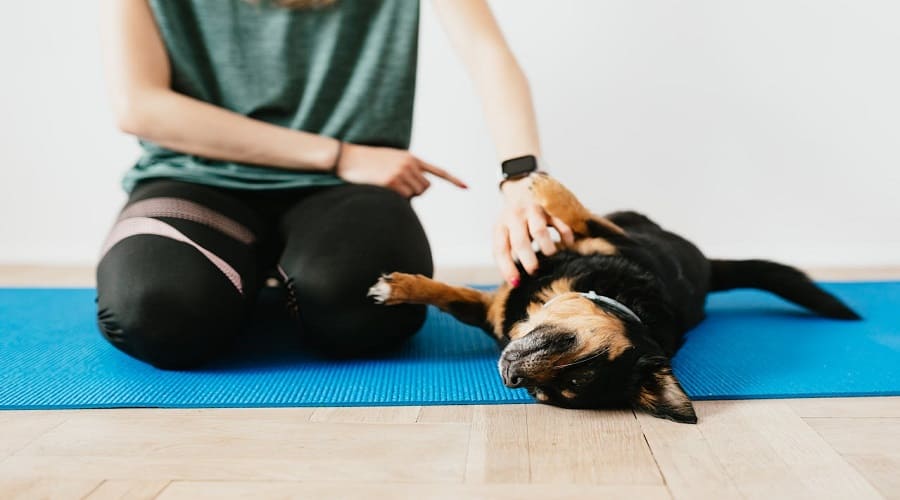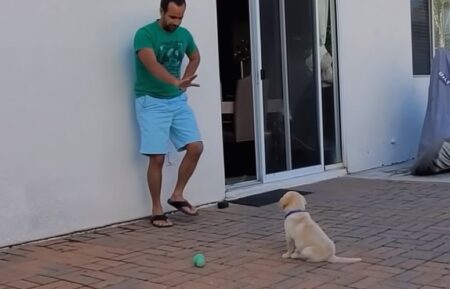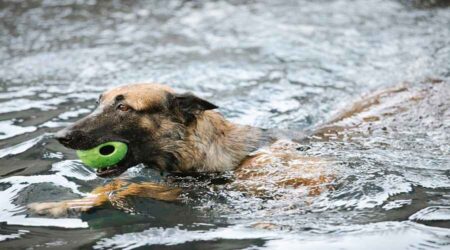Training deaf dogs differs from training dogs with good hearing in that it calls for specific methods and strategies. Trainers must modify their tactics properly because deaf dogs rely largely on visual signals and other sensory input. We’ll look at practical methods for training and interacting with deaf dogs in this tutorial. We’ll go into doable strategies to create a solid rapport and clear communication with your deaf dog friend, from using hand signals and body language to using positive reinforcement approaches. Success in training requires an understanding of the unique opportunities and problems that come with deafness in dogs. This thorough book is designed to provide you with the knowledge and abilities needed, regardless of your experience level as a dog trainer or as a new owner starting this path.
HOW TO TELL IF A DOG IS DEAF
It is necessary to observe a dog’s behavior and reactions in order to determine if it is deaf. Common indications include excessive barking or vocalization, being quickly startled when approached from behind, and showing little reaction to stimuli such as clapping or calling their name. A dog may also have hearing impairment if it is non-responsive to common auditory signals in training or in day-to-day interactions. To conclusively prove deafness, veterinarians can provide tests such as the brainstem auditory evoked response (BAER) test. Early detection of possible hearing problems in your dog can be facilitated by regular observation and knowledge of their behavior.
RESPONSE
Deafness may be indicated if your dog is not responding to sounds or auditory signals, shows signs of increased visual awareness, or appears resistant to vocal orders. Furthermore, hearing impairment may be indicated if your dog sleeps soundly without reacting to sounds around them or if they are easily startled when approached from behind. However, for a comprehensive examination and diagnosis, speaking with a veterinarian is important. They can do specialist testing to verify deafness and provide advice on how to best meet the special needs of your dog. Your deaf dog’s quality of life can be significantly enhanced by early detection and suitable accommodations.
TRY THIS SIMPLE TEST TO SEE IF YOUR DOG IS DEAF
A simple test to check your dog’s hearing involves creating a sudden, sharp noise while your dog is not looking at you. For example, you can clap your hands or make a loud noise with an object such as dropping a metal spoon on the floor. Ensure your dog is facing away from you and not aware of your actions. Observe their reaction: if they turn their head or show any sign of acknowledgment towards the noise, it suggests they can hear. However, if they do not respond at all, it could indicate potential deafness. Remember, this test provides only a preliminary indication, and a professional evaluation by a veterinarian is necessary for a definitive diagnosis.
BAER TESTING
A sophisticated process called BAER (Brainstem Auditory Evoked Response) testing is utilized to evaluate a dog’s hearing objectively. Electrodes are applied to the dog’s scalp during a BAER test in order to monitor the electrical activity produced by the auditory pathway in response to sound stimuli. Through earphones, the dog is subjected to a series of clicks or tones; a veterinarian or audiologist records and examines the subsequent brainwave patterns. This test is able to precisely identify the level of deafness in a dog as well as whether the impairment affects one ear only or both ears. Breeders, owners, and other professionals who work with deaf dogs might benefit greatly from BAER testing, which is regarded as the gold standard for identifying deafness in dogs.
TYPES OF DOG DEAFNESS
There are two primary types of dog deafness: congenital (present at birth) and acquired (developed later in life).
Congenital Deafness:
Congenital deafness is the condition in which a dog is born deaf as a result of genetics or developmental defects. It is frequently linked to specific breeds, such as Australian Shepherds, Bull Terriers, Dalmatians, and some others.
Congenital deafness can occur soon after birth or be present from birth, affecting one or both ears.
Acquired Deafness:
Dogs that were born deaf can develop acquired deafness, which is the loss of hearing in a canine after an injury, ear infection, loud noise exposure, aging, or certain medical diseases such ototoxicity.
Depending on the underlying reason, acquired deafness can affect one or both ears and progress either gradually or suddenly.
Determining the best course of action for management and treatment of a dog’s deafness requires knowledge about the breed. A veterinarian or veterinary specialist should be consulted for an accurate diagnosis and advice specific to the needs of each dog.
Congenital Deafness
Hearing loss that is apparent at birth or soon after is referred to as congenital deafness. It happens as a result of developmental defects or genetic factors that impact the auditory pathway or inner ear components. One or both ears may be affected by congenital deafness, which can range in severity from partial to total deafness.
Congenital deafness in dogs is frequently linked to particular breeds, including English Setters, Bull Terriers, Dalmatians, and Australian Shepherds, among others. A genetic mutation that predisposes these breeds to congenital deafness may exist in them. The disorder may be inherited in an autosomal recessive fashion, which means that for an offspring to be impacted, both parents must have the defective gene.
In order to manage affected pets and avoid potential safety hazards, early diagnosis of congenital deafness is essential. Accurate congenital deafness diagnosis is frequently achieved with the use of BAER (Brainstem Auditory Evoked Response) testing. Even though congenital deafness cannot be treated, dogs who are affected by it can have happy, fulfilled lives provided they receive the right care, training, and accommodations that are specific to their needs.
Other causes of deafness
Aside from congenital deafness, there are several other potential causes of deafness in dogs:
Acquired Deafness: Later in life, a number of things can cause dogs to lose their hearing, including as ear infections, ear traumas, loud noise exposure, ototoxicity from certain drugs, or aging (presbycusis).
Infections: Viral or bacterial ear infections can cause inflammation and harm to the structures responsible for hearing, which can result in either temporary or permanent deafness.
Trauma: Hearing loss can result from head trauma or ear injuries that harm the sensitive inner ear structures or auditory pathway.
Ototoxicity: Irreversible hearing loss may result from the harmful effects of some drugs or substances on the inner ear’s structures. Examples include certain medications used in chemotherapy, household chemicals, and antibiotics..
Genetic Mutations: Dogs may be predisposed to hearing loss due to genetic alterations other than congenital deafness. The auditory system’s development or operation may be impacted by certain mutations.
Tumors: Deafness may result from tumors or growths in the brain, middle ear, or ear canal that obstruct normal hearing.
Autoimmune Disorders: Certain autoimmune disorders can damage and inflame the inner ear tissues, which can lead to hearing loss.
Determining the best course of action for management and therapy of canine deafness requires identifying the underlying cause. Accurately diagnosing the precise cause of deafness may need a comprehensive evaluation by a veterinarian, which may include diagnostic tests like physical examination, orthoscopic evaluation, and maybe BAER testing.
Gradual vs sudden hearing loss in dogs
Dogs may suffer from two different forms of hearing impairment: gradual hearing loss and abrupt hearing loss.
Gradual Hearing Loss:
Gradual hearing loss is a long-term condition that frequently develops gradually over several weeks, months, or even years.
It may be connected to aging (presbycusis), a condition in which the inner ear’s structures gradually weaken with age and cause a gradual loss in hearing sensitivity.
Dogs may also gradually lose their hearing due to genetic predispositions, long-term exposure to loud noises, persistent ear infections, or underlying medical disorders that impair the auditory system.
Gradual hearing loss in dogs can manifest in subtle ways, like heightened vocalization, trouble localizing sounds, or diminished reactivity to auditory signals.
Sudden Hearing Loss:
Sudden hearing loss can be concerning for both the dog and the owner because it usually happens more quickly than gradual onset and is more evident. It also happens more quickly than gradual onset, often within hours or days.
Dogs may experience abrupt hearing loss due to a variety of conditions, including as head or ear injuries, acoustic trauma from loud noises, ototoxicity from chemicals or pharmaceuticals, infections that appear suddenly, or neurological illnesses that damage the auditory system.
When auditory input is lost abruptly, dogs who have sudden hearing loss may react with more obvious signs of discomfort or perplexity, abrupt behavioral changes, or agitation.
Regardless of the pattern of onset, a veterinarian’s timely evaluation is necessary for both progressive and rapid hearing loss in dogs in order to precisely identify the underlying cause. Dogs’ quality of life can be enhanced and the effects of hearing loss can be lessened with early detection and treatment.
How to keep your deaf dog safe
It takes more care and attention to keep your deaf dog safe in order to make up for their loss of hearing. Here are a few crucial pointers:
Visual Cues: To communicate with your deaf dog, use visual cues including hand signals, body language, and facial expressions. Use positive reinforcement training to consistently reinforce these messages.
Secure Environment: Make sure a deaf dog can feel safe and secure in your house and surroundings. To keep people out of dangerous locations, close doors and install barriers like baby gates.
Identification: Ensure that your deaf dog always wears identifying tags that include your contact details. As an extra safety measure in case they go misplaced, think about microchipping them.
Visual Aids: Use visual aids like brightly colored toys, visual markers, or vibrating collars for training and to get your dog’s attention.
Visual and Vibrating Alarms: To notify your deaf dog of significant occasions like mealtimes or crises, install vibrating or visual alerts.
Leash and Harness: When your deaf dog is outside, make sure they are always wearing a leash or harness to keep them from getting lost or into harmful circumstances.
Training: Spend some time teaching your deaf dog basic obedience instructions and visual clues for recall. To ensure they comprehend these instructions, have them practice them in various settings.
Supervision: Keep a close eye on your deaf dog, particularly in strange or potentially dangerous settings. Keep an eye out and be prepared to step in if needed.
Socialization: Assist your deaf dog in adjusting and gaining confidence by introducing them to people and other canines in restricted settings.
Make time for routine veterinary examinations to keep an eye on your deaf dog’s general health and quickly handle any possible problems.
You can assist guarantee a happy and rewarding life for your deaf dog while keeping them safe from harm by putting these safety precautions into practice and offering regular training and support.
SUPERVISE YOUR DOG
For your dog’s safety and wellbeing, especially if they are deaf, you must keep an eye on them. How to effectively oversee your deaf dog is as follows:
Constant Vigilance: Always keep an eye on your deaf dog, particularly in unfamiliar environments or situations where they may encounter potential hazards.
Close Proximity: Particularly when your dog is off-leash or in places where they could easily get into trouble, stay close to them.
Observation: Keep an eye out for any indications of distress, discomfort, or excitement in your dog’s behavior and body language. This can assist you in foreseeing and averting possible issues.
Communication: To successfully communicate with your deaf dog, use hand signals and visual cues. Make sure they can comprehend your instructions and react correctly.
Redirecting Attention: Use visual cues or tactile guidance to gently shift your dog’s attention away from any potentially dangerous object if you see them becoming fixated on it..
Training Reinforcement: Recall commands using visual cues and consistently reinforce obedience training, especially in high-risk or distracted environments.
Preventing Escape: Securely close doors, gates, and fences to keep your dog from straying or running away, particularly if they tend to bolt when frightened.
Supervision in Water: Since they can’t hear commands or warnings, keep a watchful eye on your dog if they like to swim in order to prevent mishaps.
Monitoring Play: Keep an eye on interactions amongst dogs to make sure they stay secure and constructive. If the play gets too rough or if tension or anger is evident, step in and help.
Regular Checks: To reduce the chance of an unintentional escape, periodically check your dog’s collar, leash, and identification tags to make sure they are tight and in good shape.
Keeping a careful eye on your deaf dog and speaking with them well will assist to keep them safe and avoid potential
LET YOUR FRIENDS, FAMILY MEMBERS, AND VISITORS KNOW YOUR DOG IS DEAF
It’s critical to let friends, family, and guests know that your dog is deaf in order to protect their safety and to enable productive communication with your pet. Here’s how to properly convey this information:
Verbal Communication: Inform friends, family, and guests that your dog is deaf in a clear and concise manner. To communicate this information, use clear, succinct language that highlights how crucial it is to recognize and meet your dog’s requirements.
Written Notices: Put obvious notes or indicators stating that your dog is deaf in your home or on their collar or leash. This is a useful reminder for visitors and guests to modify their interactions appropriately.
Educate About Communication: Spend some time teaching your friends, relatives, and guests how to interact with a deaf dog through body language, hand signs, and visual cues. Give advice on how to approach and engage with your pet in the most effective ways.
Set Expectations: Establish clear guidelines for how people should interact with your deaf dog: they should stay still, talk softly and slowly, and use visual signals to attract their attention.
Safety Reminders: Stress the value of taking safety measures, such as closing doors and making sure your dog is under constant supervision or on a leash, particularly when there are visitors.
Encourage Patience: Promote empathy and patience when engaging with your deaf dog. Tell your friends, family, and guests that patience is essential for effective communication and that it could take some time for your dog to react to visual clues and commands.
Answer Questions: Be ready to address any queries or worries that guests, family, or friends may have regarding your deaf dog. Give them resources and knowledge so they can comprehend the demands of your pet better.
You can foster a supportive atmosphere that protects your pet’s wellbeing and improves everyone’s experience by proactively telling others about your dog’s deafness and offering advice on how to engage with them safely and effectively.
COMMUNICATING WITH A DEAF DOG
Patience, constancy, and originality are necessary when communicating with a deaf dog. The following are some efficient means of communication for your deaf dog:
Visual Signals: To communicate instructions and hints, use body language and hand signs. Make sure that all of your signals are distinct from one another, clear, and consistent. Utilize a raised hand to indicate “sit” and a sweeping motion to indicate “come.”
Flashlights or Vibrating Collars: To grab your dog’s attention, give him a signal using a vibrating collar or a flashlight. Prior to issuing an order or signal, flash the light or turn on the vibration.
Visual Markers: For training reasons, use visual markers to designate certain locations or boundaries, like colored tape or flags. This can assist your dog in learning where to go and how to behave in various scenarios.
Positive Reinforcement: Reward desired behaviors with treats, compliments, or other forms of reinforcement. Your dog will be more likely to repeat positive behaviors if they receive positive reinforcement, which helps them associate good behavior with rewards.
Training Sessions: To teach your dog fundamental obedience instructions and other critical habits, hold frequent training sessions. As your dog learns to recognize and react to visual cues, break commands down into manageable steps and exercise patience.
Consistency: Maintain consistency in your expectations and communication. To reduce misunderstandings and strengthen learning, always use the same hand signs and cues.
Check-Ins: Make it a habit to often check in with your dog to make sure they are paying attention to you and are aware of you during activities or training sessions.
Physical Touch: When communicating with your dog, use light physical contact, such a pat on the shoulder or a soft pat on the back, to reassure or guide them.
Avoid Startling: Do not startle your deaf dog; instead, approach them carefully. Be sure they are aware of you before you approach them or make any kind of contact.
Patience and Understanding: As your dog learns to navigate the world without hearing, have patience and empathy for them. As they make progress, acknowledge it and offer assistance and motivation.
You may create a solid relationship and successfully navigate training and daily activities with your deaf dog by implementing these communication techniques into your interactions with them.Top of Form
Can deaf dogs be trained? are deaf dogs hard to train?
It is true that deaf canines can be trained! teaching a deaf dog can be different than teaching a hearing dog, but it is still completely doable with the correct methods, perseverance, and patience. Here are some important things to think about:
Visual Cues: Dogs who are deaf rely more on visual signals than spoken commands. When training them, you’ll use hand gestures, body language, and additional visual cues to convey expectations and commands.
Positive Reinforcement: Training deaf dogs is greatly aided by positive reinforcement methods such as rewarding desired behavior with toys, praise, or food. These incentives encourage your dog to keep learning and serve to reinforce positive behavior.
Consistency: When it comes to training any dog, but especially deaf dogs, consistency is essential. By using hand signals and cues consistently, you can lessen misunderstanding and assist your dog understand what is expected of them..
Patience and Persistence: When compared to teaching a hearing dog, training a deaf dog could require more time and patience. You may need to repeat exercises and commands to your dog until they fully grasp what is expected of them. Appreciate little accomplishments and exercise patience as your dog advances.
Visual Aids: Using visual aids to help focus training sessions, such as flashing lights, vibrating collars, or visual markers, can help capture your dog’s attention.
Adaptation: Be prepared to modify training methods to fit the particular requirements and learning preferences of your deaf dog. Try out several techniques and determine which ones your dog responds to the most.
Although there may be certain difficulties involved, many dog owners believe that training a deaf dog is a gratifying and meaningful experience. Like hearing dogs, deaf dogs can learn a wide range of behaviors and commands with persistence, patience, and positive reinforcement.
Training deaf dogs vs hearing dogs
Because deaf dogs cannot communicate with their hearing counterparts by sound, there are certain distinctions in training methods and strategies. Here are some important things to think about:
Communication Methods:
Hearing Dogs: The main means of communication for them are spoken commands and hints.
Deaf Dogs: Verbal orders are replaced with visual cues, hand signals, and body language.
Use of Vibrations or Lights:
Deaf Dogs: To attract a dog’s attention or indicate commands, one can use vibrating collars or flashing lights.
Hearing Dogs: Verbal cues are sufficient for communication, hence these devices are not commonly employed.
Focus on Visual Cues:
Training places a strong emphasis on the use of visual cues, which need to be distinct, observable, and obvious.
Hearing Dogs: While visual cues may also be used, training primarily revolves around verbal commands and reinforcement.
Attention and Focus: Deaf Dogs: Training frequently concentrates on developing and preserving the dog’s visual focus and handler attention.
Hearing Dogs: During training, emphasis is placed on auditory attention and responding to spoken orders.
Environmental Awareness:
Exercises designed to assist deaf dogs become more aware of their environment and react appropriately without relying on hearing may be included in their training.
Hearing Dogs: During training sessions, auditory stimuli and environmental cues are more important.
.
Patience and Adaptability:
Training Deaf Dogs: It takes persistence, tolerance, and flexibility to meet each dog’s individual needs and learning preferences.
Hearing Dogs: Training hearing dogs requires patience as well, although the focus is mostly on auditory cues and responses.
Training deaf dogs generally entails modifying conventional training techniques to account for their hearing impairment and emphasizing alternate forms of communication like signals and visual cues. Like their hearing counterparts, deaf dogs can learn and succeed in obedience training and other activities with persistence, patience, and positive reinforcement.
HOW TO TRAIN A DEAF DOG
Communicate instructions and expectations through hand signals and visual cues.
As your dog gains confidence, gradually add more complex commands, such as “come” and “sit.”
Create a Positive Environment:
Use hand signals and visual cues to convey directions and expectations.
As your dog becomes more confident, progressively introduce more difficult instructions, like “come” and “sit.”
Focus on Visual Attention:
To get your dog’s attention and train them to focus on you, use visual cues. To encourage your dog to stay focused on you and make eye contact, give them a reward.
Start with Basic Obedience Training:
Begin with basic obedience commands like “sit,” “down,” “stay,” and “comes
Use consistent hand signals for each command and practice them in different environments to generalize the behavior.
Practice Recall:
Teach your dog to come to you on command using a visual cue.
Start indoors in a low-distraction environment and gradually increase the level of distraction as your dog improves.
Socialization and Exposure:
Expose your dog to different environments, people, and animals to help them become well-adjusted and confident.
Use visual cues to guide your dog’s behavior in social situations and reinforce positive interactions.
Train in Short Sessions:
Training sessions should be kept brief (5–10 minutes) in order to keep your dog focused and avoid irritation.
For optimal effects, practice training in small bursts throughout the day.
Be Patient and Consistent:
It could take longer to train a deaf dog than a hearing dog, so be persistent and patient in your efforts.
Remain upbeat and acknowledge minor accomplishments along the route, as advancements can come gradually.
Use Visual Aids if Needed:
If required, think about utilizing visual cues to direct your dog’s attention or communicate commands, including vibrating collars or flashing lights.
Seek Professional Help if Needed:
You might want to think about getting assistance from a qualified dog trainer with experience training deaf dogs if you’re having trouble with training or have specific concerns.
These guidelines will help you educate your deaf dog successfully and create a solid friendship based on mutual comprehension and clear communication. You should also keep a cheerful and patient attitude throughout.
Use hand signals
Of course! When a dog is deaf, hand signals take precedence over other forms of communication. These hand signals are a few that are often used:Sit: Raise your hand with an open palm, moving it upward and then downward.
Down: Move your hand downward after extending your arm toward the ground with your palm facing down.
Stay: With your palm facing your dog, extend your arm forward and make a “stop” action with your hand by moving it back and forth.
Come: With your palm facing up, extend your arm outward and then make a sweeping motion toward your body.
Good Job/Praise: Give a hearty thumbs-up or a beaming smile.
No: With your palm facing down, extend your arm toward your dog and make a “stop” signal with your hand by moving it side to side.
Wait: Make a “stop” motion with your hand up and palm facing outward.
Look at Me: Give your cheek a tap or gesture to your eyes.
Release: With your palm facing up, extend your hand.
Directional Cues: To convey direction, use pointing motions, such as pointing in the direction of their bed or the door.
When teaching your deaf dog to use hand signals, consistency and repetition are key components. Your dog will eventually be able to recognize and react appropriately to these visual cues with time and effort.
Focus on luring/shaping/capturing behaviors
Luring, shaping, and capturing behaviors are useful methods for teaching new instructions and actions using visual cues while training a deaf dog. Here’s how to concentrate on every technique:
Luring:
Luring is coaxing your dog into exhibiting a desired behavior by offering a treat or an object of desire.
Use the treat you are holding in your hand to entice your dog to perform the appropriate action or position.
To train your dog to sit, for instance, place a reward above their nose and raise your hand to signal them to do so. Give them the goodie as soon as their butt reaches the ground.
Shaping:
Shaping entails rewarding progressively closer approximations of the desired behavior in order to gradually shape the behavior.
As you progress your dog toward the desired action, break it down into manageable chunks and give them treats for each one.
As an illustration, to teach your dog to “down,” praise them when they first bend their front legs, then drop their head toward the ground, and eventually lie down entirely.
Capturing:
Capturing is the process of recording and rewarding spontaneously occurring behaviors.
Treats should always be on hand, so be prepared to give your dog a treat whenever they exhibit the appropriate behavior on their own.
For instance, give your dog a treat right away if they sit to welcome you as a natural way to reinforce the habit.
It’s crucial to match each visual cue with a hand signal or gesture when utilizing these methods with a deaf dog in order to help them comprehend expectations. Reward your dog consistently and with patience for all of their accomplishments. Your deaf dog will become proficient at understanding and reacting to your visual cues with repetition and positive reward.
Give a rump tap
A tactile cue called a “rump tap” can be used to indicate a command or to catch your dog’s attention. Giving your dog a gentle touch on the rump with your hand is called a rump tap. This tactile cue can be used to encourage a desired behavior, signal a direction change, or refocus your dog’s attention. Use caution not to startle your dog by gently tapping his rump. To make the intended instruction or behavior easier for your dog to grasp, pair the rump tap with a visual cue or hand signal. Your dog will pick up on the proper way to react to this touch cue with practice and encouragement.
Use vibrations and stomping
Of course! Here’s how to efficiently communicate with a deaf dog using vibrations and stomping:
Vibrations:
Apply pressure to the ground with your foot or tap a nearby surface to produce vibrations.
You can use vibrations to send commands to your dog, such coming or changing directions, or to catch their attention.
To make an intended command or behavior easier for your dog to grasp, pair vibrations with a visual cue or hand signal.
Stomping:
To make a loud and audible vibration, stomp your foot on the ground.
Use stomping as a tactile cue to indicate commands or to gain your dog’s attention.
To strengthen comprehension and association with commands or behaviors, pair stomping with reliable hand signals or visual clues.
You can effectively communicate commands and aid in training with your deaf dog by using vibrations and stomping in conjunction with visual clues or hand signals.
Wave at them and other hand signals
Of course! Using hand signals is essential when interacting with a deaf dog. When teaching or communicating with your deaf dog, employ these useful hand gestures, such as waving:
Wave:
Raise your hand and make a waving gesture with it.
When greeting your dog from a distance, use the wave signal to capture their attention.
Sit:
Raise your arm to the sky with your palm facing upward, then sweep your hand down toward the ground.
Tell your dog to sit by giving him this signal.
Down:
With your palm facing down, extend your arm downward and make a sweeping motion with your hand toward the ground.
To get your dog to lie down, give them this signal.
Stay:
Make the sign for “stop” by holding up your hand with your fingers split apart and your palm facing outward.
When telling your dog to stay put, use this signal.
Come:
Stretch your arm outward, palm up, and then make sweeping motions with your hand toward your body.
Call your dog to you by using this signal.
Good Job/Praise:
To show admiration and approval, clap your hands or give the thumbs up.
No:
Reach out to your dog, palm down, and make a “stop” motion with your hand by moving it side to side.
Give your dog this signal when you want them to halt or desist from a certain action.
Look at Me:
To get your dog to look at you, tap your cheek or gesture toward your eyes.
When teaching your deaf dog to use hand signals, consistency and patience are essential. Your dog will be able to recognize and react to these visual signals with improved understanding with practice and good reward.
Establish a good “check-in” behavior
In distracting situations, it’s critical to establish a positive “check-in” behavior in order to sustain communication and bonding with your deaf dog. Here’s how to make this happen:
Start Indoors: Start your training in a place that is calm and has little distractions, like your house. To attract your dog’s attention, hold out a treat.
Use Visual Cue: Create a visible cue for your dog to check in with you, such as tapping your leg or waving your hand.
Reward Check-Ins: Give your dog a treat and some praise as soon as they look at you in response to the visual signal. High-value rewards might be used to encourage the behavior.
Increase Distance: Practice the check-in behavior with your dog and gradually extend your distance from them. Reward them for reacting to the visual cue even more.
Add Distractions: As you practice checking in, add small distractions like toys or other people strolling about. Give your dog a treat for staying focused on you in spite of the outside distractions.
Practice Regularly: Include check-in training into your everyday routine. To help you generalize the habit, practice in a variety of settings:
Be Patient and Consistent: Reliable check-in behavior training requires persistence and patience. To encourage your dog to check in with you on a regular basis, reinforce the behavior consistently with praise and treats.
Use Positive Reinforcement: Don’t scold or chastise your dog for failing to check in. To establish a positive association, instead concentrate on rewarding and reinforcing the desired behavior.
2. Your deaf dog can develop a strong check-in behavior that will keep them focused and connected to you in a variety of settings if you follow these instructions and are persistent in your training efforts.
Final Thoughts
To train a deaf dog, you must be persistent, dedicated, and willing to adapt your communication methods. The relationship you may develop with your deaf dog through training is tremendously fulfilling, despite any potential challenges. Keep in mind to prioritize consistency, positive reinforcement, and unambiguous hand signals and visual cues. Enjoy each little accomplishment along the road, and don’t be afraid to ask for expert assistance when necessary. You can develop a solid and affectionate bond with your deaf dog via patience, understanding, and efficient communication.






